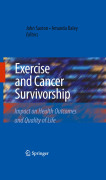
Exercise and cancer survivorship: impact on health outcomes and quality of life
Saxton, John
Daley, Amanda
An increasing number of exercise scientists are applying their skills collaboratively (with medics and physiotherapists) to clinical populations and investigating the effects of exercise in relation to wide-ranging clinical, pathophysiological and psycho-social outcomes. The book is aimed at final year Undergraduate and Master's level students of Exercise Science, who are interested in working with clinical populations such as cancer patients. Many university Sport and Exercise Science courses in the UK and USA now have modules which are focused on exercise for health, and cover aspects of exercise science which areappropriate for clinical populations. The book would also be a very valuable resource for Undergraduate and Postgraduate Physiotherapy courses and a very useful resource for students of Exercise Science and Physiotherapy, as well as practitioners working with cancer patients.There are an increasing amount of research opportunities for exercise scientists who are interested in working with clinical populations. Furthermore, a considerable amount of Government and Charity research funding is being targeted at active lifestyles and this is helping to generate a new culture of collaboration between exercise scientists and medics. Hence, it is highly likely that an increasing number of students from Sport and Exercise Science courses will pursue careers within the clinical realm in the future. Practicing exercise therapists, clinical exercise physiologists and physiotherapists would also find lots of useful up-to-date knowledge to support their evidence-based clinical practice. This book would also be of interest to informed readers who are themselves undergoing or recovering from cancer treatment. There is no book currently on the market that collates allthe most up-to-date scientific literature on exercise after a cancer diagnosis in one volume, and in relation to outcomes that are meaningful to the patients INDICE: "Introduction.- Exercise and cancer-related fatigue syndrome.- Exercise as an intervention during breast cancer treatment.- Exercise after treatment for breast cancer: effects on quality of life.- The importance of controlling body weight after a diagnosis of breast cancer: the role of diet and exercise in breast cancer patient management.- The biological mechanisms by which physical activity might have an impact on outcome/prognosis after a breast cancer diagnosis.- Exercise after prostate cancer diagnosis.- Exercise for prevention & treatment of prostate cancer: cellular mechanisms.- Physical Activity Before and After Diagnosis of Colorectal Cancer.- Exercise-based rehabilitation in patients with lung cancer.- Exercise and cancer mortality.- Ready to change lifestyle? The feasibility of exercise interventions in cancer patients.- Cardiorespiratory Exercise Testing in Adult Cancer Patients."
- ISBN: 978-1-4419-1172-8
- Editorial: Springer
- Encuadernacion: Cartoné
- Páginas: 202
- Fecha Publicación: 01/11/2009
- Nº Volúmenes: 1
- Idioma: Inglés
